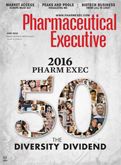Design that Delivers
Pharmaceutical Executive
Pharm Exec explores the power of workplace aesthetic on the intangibles of culture, morale-and corporate mission-in a visit to one big Pharma's unique US headquarters.
Can the physical spaces we work in shape our relationship to the larger world outside? Is a workplace aesthetic founded on the engineered configuration of steel, wood, stone and glass helpful in strengthening a company’s morale and mission-extending even to its underlying culture and values? The two questions are getting serious scrutiny from today’s big Pharma players as they
William Looney

grapple with the challenge of keeping their employees healthy, productive and engaged. In fact, it’s a crucial adjunct to our cover feature this month on why future revenue growth in this industry depends on investing big in that diverse intangible called the “people factor.”
To further explore the issue of housing the business enterprise, Pharm Exec recently paid a visit to GlaxoSmithKline’s four-floor, 208,000 square foot US headquarters at Philadelphia’s historic Navy Yard. Home to 1,100 employees, the new office, opened in early 2014, was positioned as the practical expression of a new corporate identity built around a transparent, three-pronged commitment to the patient. Simply put, GSK wants everyone taking a GSK medicine to feel better; live longer; do more.
A survey of employees based at GSK’s aging downtown Franklin Plaza high-rise helped shape the Navy Yard renovation led by award-winning Yale University architect Robert Stern, himself an early advocate of energy- and environmentally-responsive design principles. The survey found that colleagues found the existing set-up “demotivating,” with its 16-floor vertical accessible mainly by elevator and divided into claustrophobic, low-ceilinged interior spaces that reinforced silos among functions and actually encouraged unhealthy personal behaviors.
In response, GSK opted to build its three mission objectives right into the new design. To advance the commitment to “do more” for patients, the plan set about to raise employee productivity by making access to the facility convenient and easy; providing workers with a variety of shuttle bus, bicycle and other transport options and time-saving retail services; removing interior walls and doors; banning individual private offices; and introducing a natural openness, light and flow among work stations. The design signal to colleagues was manifestly clear: find each other, collaborate and stretch the mind and body in doing so.
The facility also takes a novel approach to the visual presentation of ideas and information. Instead of a statically positioned display of framed art, GSK opted to use the walls and other surfaces as canvases in themselves, using drawings, words and symbols often used in science to bring sections of the building together-an ever-changing visual stimuli that encourages people to comment, follow and explore what’s at the end. This way, the message is reinforced that everything-and everyone-in the building is connected.
The other health-related goals-to feel better and live longer-were expressed in two ways, first by improving on wellness metrics among the GSK workforce and, second, to showcase the company’s corporate responsibility as an industry standard-setter on community health, energy conservation and environmental safety. A natural ambience is projected right at the building entrance, in the form of an enormous, light-filled atrium punctuated by a spiral wood stairway resembling the iconic form of the DNA double helix. The central stairs works as a sort of Greek-style agora, or meeting place, where employees have no choice but to literally bump into each other. Elevators still exist, but they are purposefully hidden from sight.
Inside GSK's US headquarters at Philadelphia's historic Navy Yard.

Two years on, the results are in.
From the start, the Navy Yard operation has led the US biopharma industry in achieving a progressively lower energy and environmental footprint. The building itself rates a rare “double platinum” LEED status for innovation in energy and environmental design, one of less than 10 (and the sole entry in pharmaceuticals) commercial facilities in the US to do so. Ron Joines, GSK vice president for environment health safety and sustainability, points to other milestones. “We’ve managed to slash energy consumption to one quarter the level it was at the Franklin Plaza building,” he says. “All of our internal materials, from paint to fixtures to machines, are chosen for maximum energy efficiency, and at the lowest level of potentially harmful emissions; the employee parking lot is equipped with chargers for electric vehicles. We think it important for a company that leads in treatments for respiratory disease that our carbon and emissions footprint be as low as possible.”
“We’ve accomplished what we set out to do,” says Joines. ‘’We inhabit a built environment that reflects and reinforces our values and what our employees expect when they join GSK.” And that pregnant question-whether an appealing workplace ambiance adds heft to those critical markers of corporate identity, culture, productivity, reputation and morale-is being answered in the affirmative. “The bias in the design was to promote human movement and interactions throughout the work day,” says Joines. “Our surveys show that at any given time, a third of Navy Yard colleagues are either in motion around the facility, standing or treading in place at their work stations.” Considerable investments have been made in these work stations to give colleagues a variety of choices suitable to their desired level of physical activity.
At the same time, in accordance with the company’s emphasis on diversity, disabled GSK colleagues benefit from one of the most accessible built environments in the country. It’s also a safe place: Joines reports not a single incidence of musculoskeletal injury among staff in the first two years at the Navy Yard site, while the number of reported thefts of company and employee property has dropped from twice a month at the old downtown office to a new record-zero for all of 2015. More important, data from GSK’s annual individual employee health risk appraisal reveals an average 56% gain in the amount of movement per employee since the migration to the Navy Yard.
From an employee wellness perspective, GSK’s signature initiative is its in-house Energy and Resilience campaign geared to helping workers to manage their energy. “We see stress as a major, often hidden condition that hurts productivity and carries adverse physical consequences. It must be addressed by looking at the individual as a whole person, not just what he or she does at work,” Joines told Pharm Exec. “The holistic environment we have created here at the Navy Yard is an important contributor to this effort because it actually makes it easier for people to expend their emotional and physical capabilities in a mindful, constructive way.”
SMART technology controls that maximize natural ambient light, subtle use of calming, noise-altering audio, and wireless networking and soft phones are the foundation, but the company also offers more than a dozen wellness programs/workshops on site designed to help colleagues manage their lives based on a higher standard of physical and mental awareness.
Looking carefully at the GSK embrace of a new set of aesthetics for the workplace, the company was an early mover on ways that a designed environment might boost those fuzzy ROI metrics on employee engagement, culture and reputation. But other big Pharma players-Novartis and AZ are worth noting here-have adopted the same playbook and the rest of the industry is not far behind.
It’s all about alignment-between the spiritual and temporal, between the life mission and the work mission. It’s a fact that most people in a knowledge industry like biopharmaceuticals will end up spending the bulk of their lives at work, because there is no fixed time to solve a problem raised by science. The choices are abundant, risks are endemic and answers are most always elusive. So why not make the office a little more like the safe house of home?
William Looney is Editor-in-Chief of Pharm Exec. He can be reached at william.looney@ubm.com. Follow Bill on Twitter: @BillPharmExec


.png&w=3840&q=75)

.png&w=3840&q=75)



.png&w=3840&q=75)



.png&w=3840&q=75)










